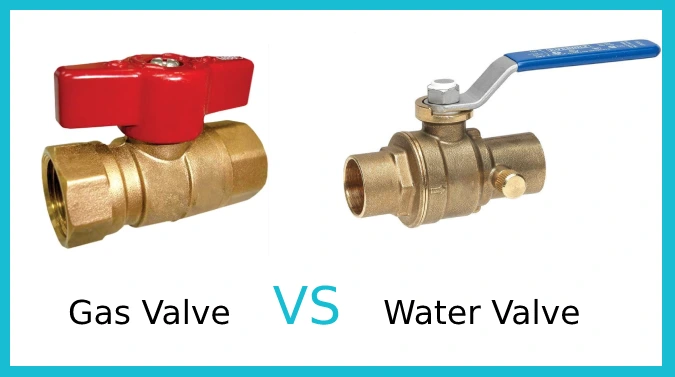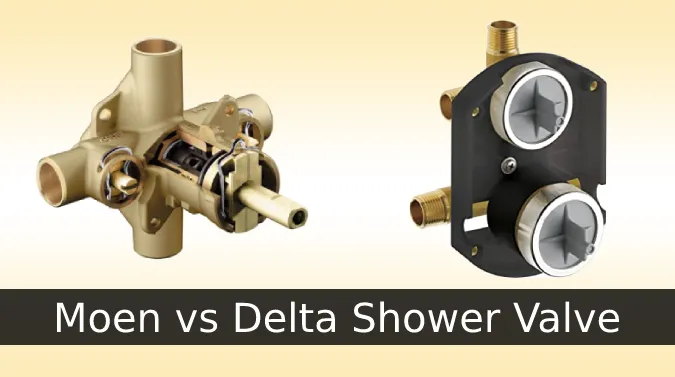Last Updated on May 22, 2023
Upgrading the plumbing system needs to understanding the differences between two main options: pressure balance and thermostatic mixing valves. Both valves are designed to maintain a consistent water temperature, but each has its own unique approach to achieving this goal.
Knowing the differences between these types of valves: PBV and TMV can help you make the best decisions for your home or office.
One of the main differences between these valves is that PBVs regulate the water flow by balancing the pressure of hot and cold water. In contrast, TMVs regulate the temperature by mixing the hot and cold water in specific proportions.
This key distinction has implications for the safety, accuracy, flow rate, complexity, and installation of the two valve types. Let’s dig into the nitty-gritty of PBVs vs. TMVs to figure out which is right for you.
Differences Between Pressure Balance Vs Thermostatic Mixing Valve

Discover the distinctions between pressure balance and thermostatic mixing valves below. Explore now for valuable insights.
1. Mechanism and Sensing
Pressure balance valves sense the pressure ratio of hot and cold water, while thermostatic mixing valves sense the water temperature to adjust the hot and cold water ratio.
PBVs work by monitoring the pressure difference between hot and cold water. If there is a sudden drop in pressure on one side, the valve will adjust to maintain a steady water flow.
This is particularly important in scenarios where the water pressure fluctuates due to different water users, such as flushing toilets or turning on other faucets.
TMVs, on the other hand, sense the water’s temperature and regulate the hot and cold water flow to maintain a constant temperature.
By using a thermal element that expands or contracts based on the water temperature, TMVs can accurately regulate the water temperature.
2. Safety
There is greater safety associated with TMVs than with PBVs. These valves are designed to regulate water temperature by balancing the hot and cold water supplies.
They also can shut off the water flow if either the hot or cold supply fails, which is impossible with pressure balance valves (PBVs).
This feature is especially important in hospitals, nursing homes, and other facilities where vulnerable populations risk scalding injuries.
Also, TMVs offer greater accuracy in temperature regulation than PBVs. They can maintain a consistent temperature despite fluctuations in water pressure.
This is due to their ability to sense changes in the temperature and pressure of the water supply and adjust the flow of hot and cold water accordingly. This ensures that the water temperature remains safe, protecting users from burns or scalds.
3. Control and Interface
TMVs feature two knobs for controlling the output temperature and volume, ensuring the water is not too hot or cold.
This is especially important in healthcare settings where patient safety is paramount and hot water can easily cause burns and scalds.
Conversely, PBVs offer limited control over the temperature and have a single control knob for both temperature and volume.
4. Accuracy
Compared to pressure balance valves (PBVs), TMVs offer more accurate temperature control, maintaining the temperature within a few degrees of the setpoint.
This is achieved through a temperature-sensitive element within the valve that adjusts the flow of cold and hot water to maintain a consistent mixed temperature.
Although PBVs can somewhat control the temperature, they are not as precise as TMVs, which can lead to fluctuations in water temperature and potential safety risks.
Also, TMVs can be customized to suit specific applications, with different flow rates, temperature ranges, and pressure settings available.
This allows for greater flexibility in design and installation, ensuring that the thermostatic valve can provide accurate temperature control in a wide range of settings.
5. Flow Rate
Maintaining a consistent water flow rate at a specific temperature is crucial to ensuring optimal performance and safety of plumbing systems. In this regard, thermostatic mixing valves (TMVs) are highly advantageous because they offer a constant flow rate regardless of pressure changes.
In contrast, pressure balance valves (PBVs) can be affected by changes in water pressure, which can lead to a fluctuation in flow rate.
Therefore, PBVs may not be suitable for plumbing systems requiring constant flow rates, such as those used in hospitals and other healthcare facilities.
6. Complexity
TMVs are generally more complex than PBVs. They have additional components, such as temperature sensors, thermostatic cartridges, and check valves, which require specialized knowledge to install and maintain.
Aside from that, TMVs need to be calibrated precisely to ensure they deliver water at the desired temperature, which can be time-consuming and delicate.
The complexity of TMVs and PBVs presents challenges when troubleshooting problems. Plumbers need to thoroughly understand the valves’ design and operation to identify and fix issues.
Also, the calibration of TMVs and PBVs can be affected by external factors such as water pressure, temperature, and mineral content. As such, plumbers need to be able to diagnose and address these factors to maintain optimal valve performance.
7. Cost
When comparing the cost of pressure balance and thermostatic mixing valves, pressure balance valves are generally less expensive due to their simpler design and less sophisticated technology.
The installation costs for both types of valves are similar, although thermostatic mixing valves may require additional piping. Maintenance costs for thermostatic mixing valves may be higher due to the more complex design and technology.
A faulty thermostatic mixing valve may be more expensive to fix or replace than a pressure balance valve. But by increasing energy efficiency and improving temperature regulation, thermostatic mixing valves can save you money in the long run.
Which is Better: Pressure Balance vs Thermostatic Mixing Valve?

Pressure balance valves are an affordable and simple option, but they lack the capability to adjust for changes in water temperature. This can result in sudden bursts of hot or cold water, which can be uncomfortable or even dangerous.
A thermostatic mixing valve is better for those who prioritize safety and consistent temperature control.
While they tend to be more expensive and require professional installation, they use a sensing element to measure the temperature of the water and adjust the mix of hot and cold water to maintain a constant temperature, even if there are changes in water pressure.
Ultimately, the decision between these two types of valves depends on individual needs and preferences. Still, for those who value safety and comfort, a thermostatic mixing valve is the recommended choice.
Where should pressure balancing valves be placed?
To ensure consistent temperature and pressure, pressure balancing valves should be placed at the end of each domestic hot water supply line before the return line.
This placement is crucial because it prevents hot water from surging or fluctuating temperature due to changes in the overall water system’s pressure. But, pressure-balancing valves do not solve particulate or dirt problems in water systems.
In systems with these issues, installing a strainer upstream of the pressure balancing valve is recommended to prevent clogs and damage to the valve itself.
Where are thermostatic mixing valves required?

Thermostatic mixing valves are required in various applications where hot water is delivered for domestic or commercial use.
Building codes often require these valves for new construction or renovation projects in residential settings. It’s essential in bathrooms where young children or elderly individuals may be using the facilities.
In commercial settings, they are often required in healthcare facilities, schools, and other public buildings to ensure the safety of users. Thermostatic mixing valves are also necessary for applications with a risk of Legionella bacteria growth.
These valves help prevent the growth of bacteria by maintaining a consistent water temperature high enough to kill off harmful microorganisms. This is particularly important in large hot water systems used in hospitals, hotels, and other commercial buildings.
Do thermostatic shower valves fail?
Thermostatic mixing valves are required in certain settings to prevent scalding accidents. Like any mechanical component, they can fail over time.
The common causes of failure include mineral buildup, corrosion, and mechanical wear and tear. These factors can affect the valve’s ability to accurately regulate temperature, leading to either scalding or cold water shock.
Mineral buildup can occur gradually if the water in the area is hard, impacting the valve’s performance. Corrosion can also damage the valve’s internal components due to exposure to moisture and other elements.
Mechanical wear and tear can cause the valve to become less effective at regulating temperature, leading to an inconsistent water flow.
Despite these possible failures, thermostatic shower valves are designed to be reliable and long-lasting.
How long do thermostatic shower valves last?

The lifespan of a thermostatic shower valve can vary depending on factors such as quality, usage, and maintenance. But, on average, it can last between 5 to 20 years. It is important to note that this is just an estimate and that the actual lifespan may be shorter or longer than this range.
To ensure that your thermostatic shower valve lasts as long as possible, it is important to take proper care of it. This includes regular maintenance, such as cleaning the valve and ensuring that it is not clogged with debris.
It is also important to use the valve correctly and not subject it to excessive wear and tear, such as using it to control water pressure that is too high.
Also, choosing a high-quality thermostatic shower valve from a reputable manufacturer can help ensure that it lasts as long as possible.
What is the best way to find a reliable, high-quality thermostatic mixing valve?
Discovering a dependable and first-rate thermostatic mixing valve can be a daunting task. But don’t fret. We’ve taken the time to review the best thermostatic mixing valve in the market.
So you can avoid the hassle of sifting through multiple products and sites. Our reviews are a concise and reliable source that will save you time and guarantee that you acquire a product that will match your standards.
PBV vs TMV: Find Your Perfect Home Match
In conclusion, selecting between a pressure balance valve (PBV) and a thermostatic mixing valve (TMV) depends on various factors such as the flow rate, accuracy, complexity, and installation requirements.
While PBVs control water flow by balancing hot and cold pressure, TMVs regulate the temperature by mixing them in specific proportions.
Although both valves serve similar purposes, TMVs offer greater temperature regulation accuracy and safety capabilities. They’re perfect for hospitals and nursing homes with vulnerable populations.
Ultimately, a high-quality thermostatic mixing valve can provide peace of mind and a comfortable showering experience.



